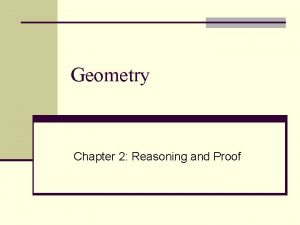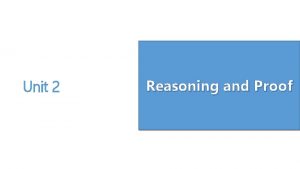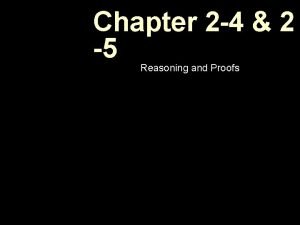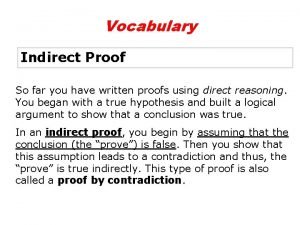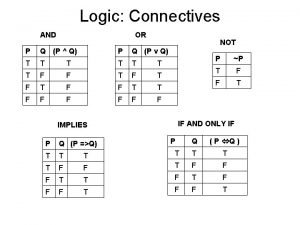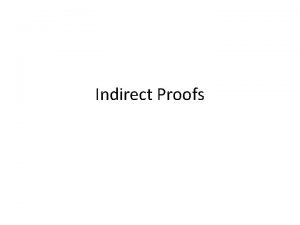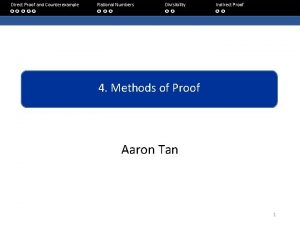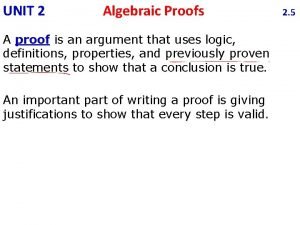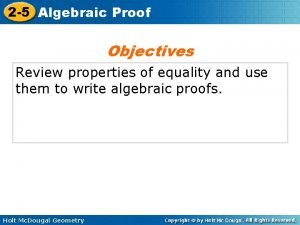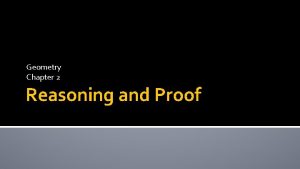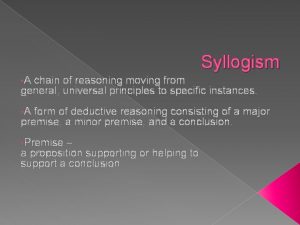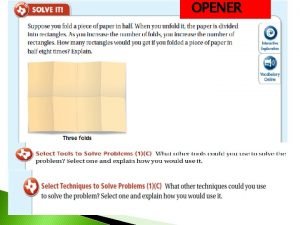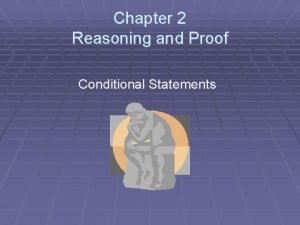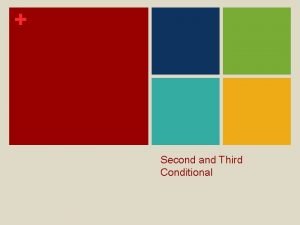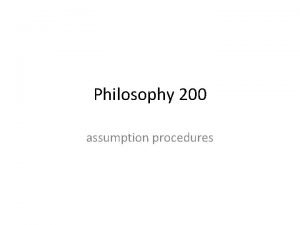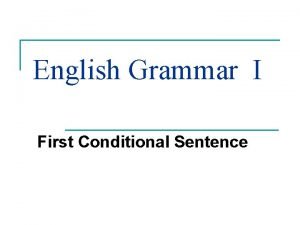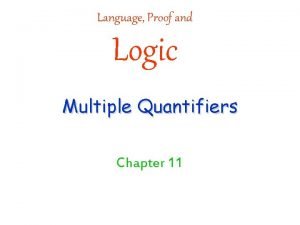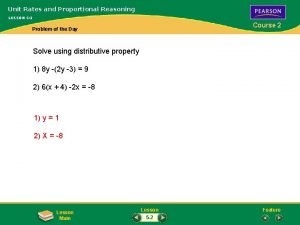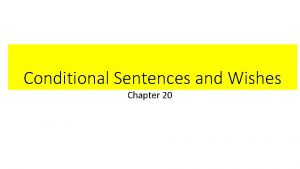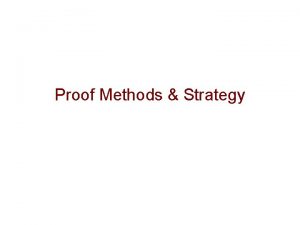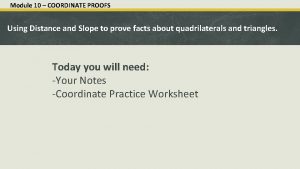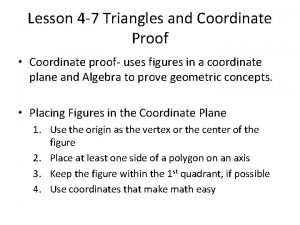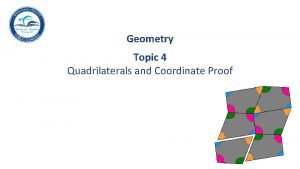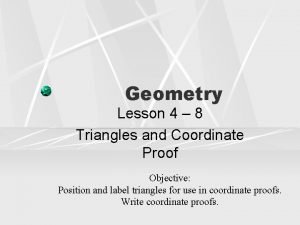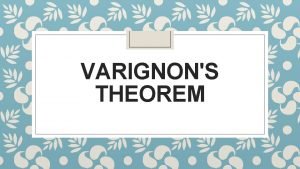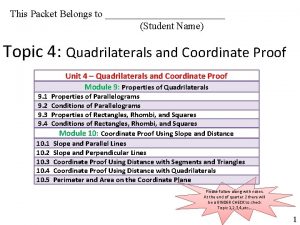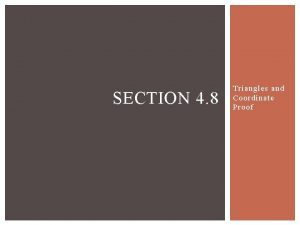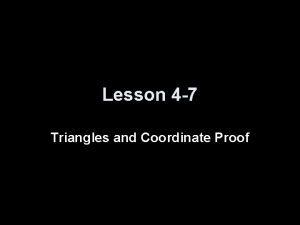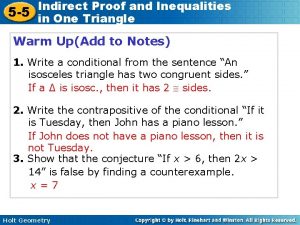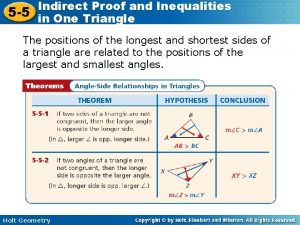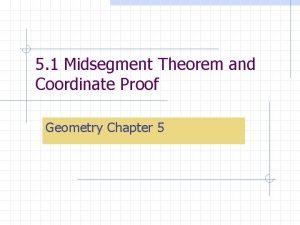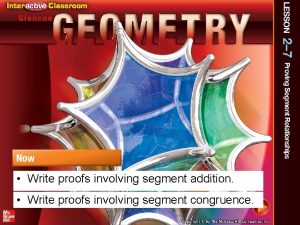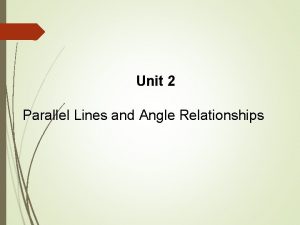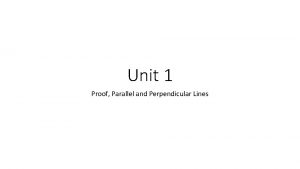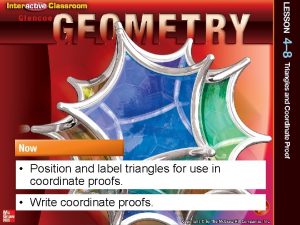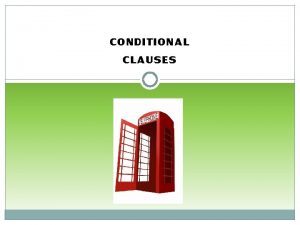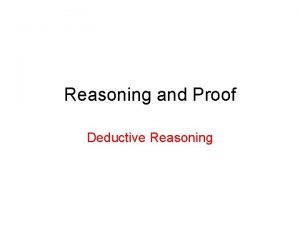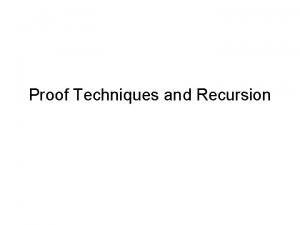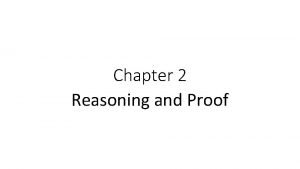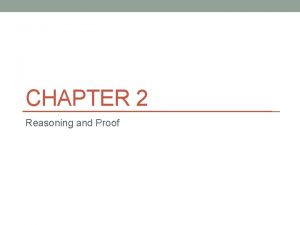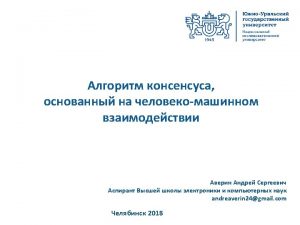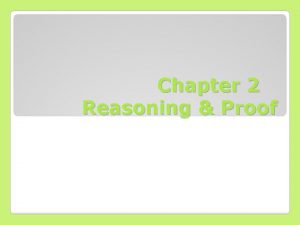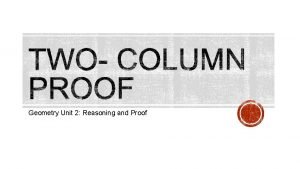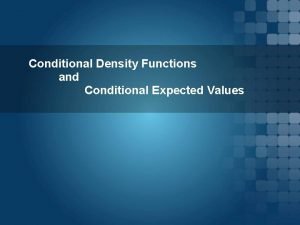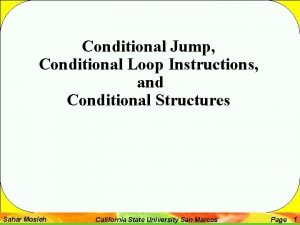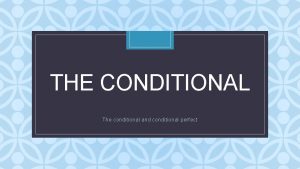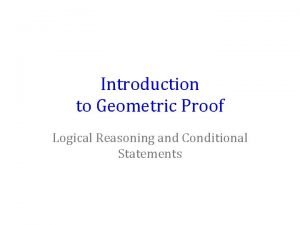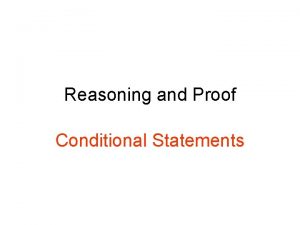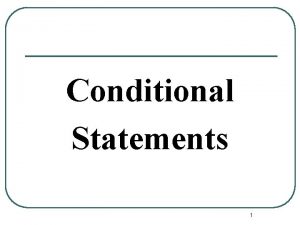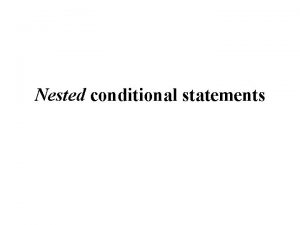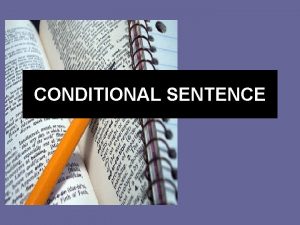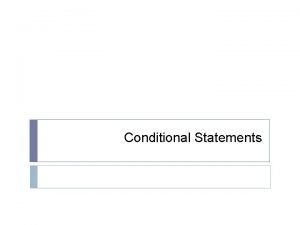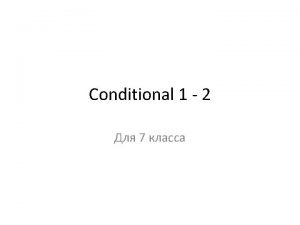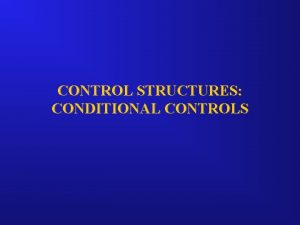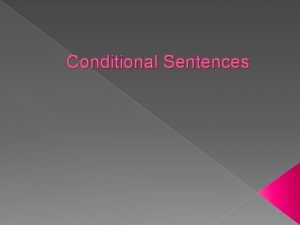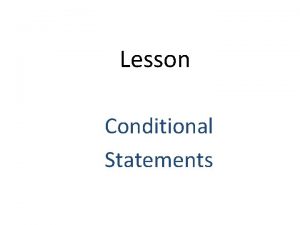Chapter 2 Reasoning and Proof 2 1 Conditional












































- Slides: 44

Chapter 2 Reasoning and Proof

2 -1 Conditional Statements EQ: Identify parts of conditional statements • Give examples of if-then statements • Another name for an if-then statement is a conditional. • Conditionals have two parts: a hypothesis and a conclusion. • Statement: Triangles have three sides. • Conditional: If a shape is a triangle then it has three sides hypothesis conclusion

2 -1 Conditional Statements EQ: Identify parts of conditional statements • Write each statement as a conditional 1. 2. 3. 4. A bicycle has two wheels My birthday cake is chocolate i. Phones cost too much money Geometry students always do their homework

2 -1 Conditional Statements EQ: Identify parts of conditional statements • A conditional can have a truth value of true or false. • To show that a conditional is true, show that every time the hypothesis is true, the conclusion is also true. • To show a conditional is false, you need to find only one counterexample for which the hypothesis is true and the conclusion is false.

2 -1 Conditional Statements EQ: Identify parts of conditional statements • Venn Diagrams can show whether a conditional is true or false. • If you live in Rocklin then you • live in California • If you live in California then • you live in Rocklin

2 -1 Conditional Statements EQ: Identify parts of conditional statements • The converse of a conditional switches the hypothesis and the conclusion. • Conditional: If a figure has three sides then it is a triangle. • Converse: If a figure is a triangle then it has three sides. What is the converse? If I have $10 then I can afford a movie ticket. If I don't wake up on time then I will be late for school.

2 -1 Conditional Statements EQ: Identify parts of conditional statements • A statement and its converse may not have the same truth value. • Come up with a statement that is true for both the statement and its converse. • Come up with a conditional that is true, but its converse is false. • Come up with a conditional that is false, but its converse is true.

2 -1 Conditional Statements EQ: Identify parts of conditional statements

2 -2 Biconditionals EQ: What makes a biconditional statement? • When a conditional and its converse are true you can combine them to form a biconditional • You can combine the two parts of each conditional with if and only if • If two angles have the same measure then they are congruent • If two angles are congruent then they have the same measure. • Two angles have the same measure if and only if they are congruent.

2 -2 Biconditionals EQ: What makes a biconditional statement?

2 -2 Biconditionals EQ: What makes a biconditional statement? • You can separate a biconditional into parts. • Biconditional: Two angles are supplementary if and only if the sum of their angles is 180˚ • If two angles are supplementary then the sum of their angles is 180˚ • If the sum of two angles is 180˚ then the angles are supplementary.

• Homework: • page 83 (1 -33) odd • page 90 (1 -23) odd

• Warm Up: • Write the converse of each statement 1. If you don’t sleep much, then your grades will suffer. 2. If you want to arrive on time, then you must start early. • Write each statement as a conditional. 3. Leap years have 366 days 4. Two lines that are perpendicular meet to form right angles 5. Every sixteen year old is a teenager. Are any of the above statements biconditionals?

2 -3 Deductive Reasoning EQ: Give examples of deductive reasoning • Deductive reasoning is the process of reasoning logically from given statements to a conclusion. • An auto mechanic knows that if a car has a dead battery it will not start. A mechanic begins to work on a car and finds the battery is dead. What conclusion can the mechanic make? • What if the mechanic begins to work on a car and finds it won't start. Can the mechanic conclude the car has a dead battery?

2 -3 Deductive Reasoning EQ: Give examples of deductive reasoning • If a conditional is true, and the hypothesis is true, then the conclusion is true. • Called the Law of Detachment • Given: If it is snowing, then the temperature is below 32 degrees. • It is snowing. • It is 17 degrees.

2 -3 Deductive Reasoning EQ: Give examples of deductive reasoning • Given: If the road is icy, then driving conditions are hazardous. • Driving conditions are hazardous. • The road is icy.

2 -3 Deductive Reasoning EQ: Give examples of deductive reasoning • If p �q and q �r then p �r • Called the Law of Syllogism • If there is a baseball game at the stadium then people eat sunflower seeds. • If people eat sunflower seeds then there are shells on the ground. • If there is a baseball game there are sunflower seed shells on the ground.

2 -3 Deductive Reasoning EQ: Give examples of deductive reasoning • What can you conclude? • If a number ends in 0, it is divisible by 10. • If a number is divisible by 10, then it is divisible by 5. • If a number ends in 6, then it is divisible by 2. • If a number ends in 4, then it is divisible by 2.

2 -3 Deductive Reasoning EQ: Give examples of deductive reasoning • Deductive Reasoning game • You will each get an index card. Write your name and one true fun fact about yourself that you think no one else knows. • for example: I have never been to Disneyland • I have ridden on the back of an elephant • I can fly an airplane • I will be reading these facts out loud exactly how you write them

• As I read the facts, take notes and write them down. • Each student will get to ask one yes or no question of any one student. • You MUST answer the question truthfully. • At the end of the game, we will see how many answers you got right!

2 -3 Deductive Reasoning EQ: Give examples of deductive reasoning • Exit pass: worksheet • Homework: • page 96 (1 -32, 38 -44) all • Review packet for make up test on Friday







warm up

2 -5 Proving Angles Congruent EQ: What is the difference between a postulate and a theorem? • You can use deductive reasoning to show that a conjecture is true. • The set of steps you take is called a proof. • The statement you prove true is a theorem.

2 -5 Proving Angles Congruent EQ: What is the difference between a postulate and a theorem?

2 -5 Proving Angles Congruent EQ: What is the difference between a postulate and a theorem? • • • statement m<1 + m<3 = 180° m<2 + m<3 = 180° m<1 + m<3 = m<2 + m<3 m<1 = m<2 reason

2 -5 Proving Angles Congruent EQ: What is the difference between a postulate and a theorem?

2 -5 Proving Angles Congruent EQ: What is the difference between a postulate and a theorem?

• More Angle Theorems • homework: p 112 (1 -7, 12 -18) all

chapter 2 vocabulary review 1. _________is the process of reasoning logically from given facts to a conclusion. 2. The ______is the part of a conditional statement that follows the “then. ” 3. The _______of the conditional statement “if p then q” is “if q then p. ” 4. A ______ is the combination of a conditional statement and its converse. It contains the words “if and only if. ”

chapter 2 vocabulary review 5. The ______means that AB = AB. 6. The ________states that if the conditional “if p then q” is true, and p is true, then q is true. 7. A ________ is an if-then statement. 8. The ________of a conditional is true or false, depending on whether the statement is true or false. 9. The ________means that if AB = CD then CD = AB.

chapter 2 vocabulary review 10. The _______ is the part that follows “If” in a conditional statement. 11. A _______ is a conjecture that has been proven. 12. The ________states that if A=B and B=C then A=C. 13. The _______ states that “if p then q” is true, and “If q then r” is true, then “If p then r” is true.

Chapter 2 Review






 Chapter 2 reasoning and proof
Chapter 2 reasoning and proof Unit 2 logic and proof inductive reasoning
Unit 2 logic and proof inductive reasoning Chapter 2 reasoning and proof answer key
Chapter 2 reasoning and proof answer key Direct proof and indirect proof
Direct proof and indirect proof Direct proof and indirect proof
Direct proof and indirect proof Proofs
Proofs Direct proof and indirect proof
Direct proof and indirect proof Unit 2 logic and proof homework 1
Unit 2 logic and proof homework 1 Direct algebraic proof
Direct algebraic proof Reasoning and proof unit test
Reasoning and proof unit test Reasoning and proof unit test
Reasoning and proof unit test Unit 1 reasoning and proof answers
Unit 1 reasoning and proof answers Deductive method
Deductive method Inductive approach
Inductive approach Proving conditional statements
Proving conditional statements Deductive reasoning definition
Deductive reasoning definition Inductive and deductive reasoning
Inductive and deductive reasoning Inductive reasoning
Inductive reasoning Every quiz has been easy. therefore the quiz will be easy
Every quiz has been easy. therefore the quiz will be easy Inductive reasoning patterns
Inductive reasoning patterns The real conditional
The real conditional Conditional proof
Conditional proof 1st conditional sentences structure
1st conditional sentences structure Language proof and logic solutions chapter 11
Language proof and logic solutions chapter 11 Course 2 chapter 1 ratios and proportional reasoning
Course 2 chapter 1 ratios and proportional reasoning Chapter 20 conditional sentences and wishes
Chapter 20 conditional sentences and wishes Non constructive proof
Non constructive proof Module 10 coordinate proof using slope and distance
Module 10 coordinate proof using slope and distance 4-8 triangles and coordinate proof
4-8 triangles and coordinate proof Unit 3 quadrilaterals and coordinate proof
Unit 3 quadrilaterals and coordinate proof What proof uses figures on a coordinate plane to prove
What proof uses figures on a coordinate plane to prove Varignon's theorem helps to find
Varignon's theorem helps to find Coordinate proof using slope and distance
Coordinate proof using slope and distance Position and label each triangle on the coordinate plane
Position and label each triangle on the coordinate plane Proof methods and strategy
Proof methods and strategy 4-7 practice triangles and coordinate proof
4-7 practice triangles and coordinate proof Lesson 5-5 indirect proof and inequalities in one triangle
Lesson 5-5 indirect proof and inequalities in one triangle Indirect proof and inequalities in one triangle
Indirect proof and inequalities in one triangle 5-5 indirect proof and inequalities in one triangle
5-5 indirect proof and inequalities in one triangle Midsegment theorem and coordinate proof
Midsegment theorem and coordinate proof Sum and differnce formula
Sum and differnce formula Angle addition postulate proof
Angle addition postulate proof Segment and angle proof reasons scavenger hunt
Segment and angle proof reasons scavenger hunt Geometry unit 1 proof parallel and perpendicular lines
Geometry unit 1 proof parallel and perpendicular lines 4-8 triangles and coordinate proof
4-8 triangles and coordinate proof
